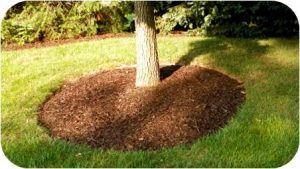 Homeowners and arborists depend on mulch in landscapes for several reasons. Functionally, mulches discourage weeds from growing, conserve moisture during drought periods, and allow better use of water by controlling runoff and increasing water-holding capacity of light, sandy soils. Mulches help maintain a uniform soil temperature. A 3- 4 inch layer of mulch can add to the aesthetic value of a garden while protecting the base of trees from being injured by equipment, such as lawn mowers. Mulch rings also decrease competition from lawn grass. Lawn grass, especially when lush, robs trees of valuable nutrients and moisture. Many organic materials can be used as a mulch. Bark mulches and wood chips are the two most commonly used mulches in most of the country. In the south, pine needles are included in that list.
Homeowners and arborists depend on mulch in landscapes for several reasons. Functionally, mulches discourage weeds from growing, conserve moisture during drought periods, and allow better use of water by controlling runoff and increasing water-holding capacity of light, sandy soils. Mulches help maintain a uniform soil temperature. A 3- 4 inch layer of mulch can add to the aesthetic value of a garden while protecting the base of trees from being injured by equipment, such as lawn mowers. Mulch rings also decrease competition from lawn grass. Lawn grass, especially when lush, robs trees of valuable nutrients and moisture. Many organic materials can be used as a mulch. Bark mulches and wood chips are the two most commonly used mulches in most of the country. In the south, pine needles are included in that list.
Mulch can be applied just about any time of the year when trees and shrubs are being planted. The best time, however, to apply mulch in established bed areas would be in mid-spring when the soil temperature has warmed up enough for sufficient root growth. If applied earlier, the mulch will keep the soil temperature lower and root growth could be delayed. Mulches should be applied 2 to 3 or 4 inches in depth over relatively clean, weed-free soils. Do not pile mulch more than 4 inches. Identify and eradicate the weeds before the mulch is applied. Keep mulch pulled 12 inches back from the tree trunk. Most arborists consider organic mulches as the most compatible with trees. There are, however, several inorganic materials used as mulches. These include weed barriers. Black plastic is sometimes used to discourage weeds, however it interferes with the normal oxygen and water supply to the tree’s roots. When the plastic is used, a very shallow root system is created and during drought periods the plants may not withstand the stress. It is recommended not to use black plastic around trees.
There are, however, several landscape fabric “mulches” available that will function the same as plastic, but allow for normal water and oxygen exchange. These materials, sometimes called geotextiles or weed barriers, are placed on bare soil around trees and shrubs with mulches used on top. There are many brands and types of materials from which to choose. They have proven to be beneficial in discouraging weeds and conserving soil moisture.
